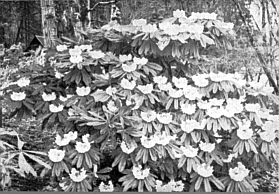QBARS - v19n3 Experiences in Breeding for Indumentum
Experiences in Breeding for Indumentum
Cecil Smith, Aurora, Ore.
Indumentum is the hairy covering found on the underside of the leaves of some rhododendrons. It is usually soft and velvet-like to the touch. It varies in color from white, as in R. uvarifolium , to a rich reddish-brown, as in R. bureavii A.M. A few species have a light tomentum on the upper surface of the young leaves, as in R. eximium .
The mature leaves with colorful undersides are interesting the year around, and especially so when the plant reaches eye height. However, to me, the main interest is in the new growths of some species. Many have uninteresting flowers. The problem is to improve the quality of the flowers and still retain the foliage quality. It would appear that very little breeding has been done with this goal in mind.
About 1955 1 acquired a six-inch plant of R. yakushimanum from W. R. Peterson, a Portland nurseryman, who had grafted it. The scions were furnished by George Grace, a long time fancier and importer, who received them from Francis Hanger of Wisley.
About a year later, I received some small seedling R. yakushimanum crosses from John Henny, the first president of the A.R.S. Hanger had made the crosses and sent the seed to John. These crosses were: fortunei X yakushimanum 'Norman Gill' X yakushimanum 'Jalisco' X yakushimanum 'Pilgrim' X yakushimanum 'Fabia' X yakushimanum.
When these crosses bloomed, I crossed them with each other, with siblings, and back-crossed them. The only crosses with heavy indumentum were those of 'Fabia' X yakushimanum and fortunei X yakushimanum , backcrossed to yakushimanum . None of either the 'Fabia' x yakushimanum crosses or the back-crosses was thought desirable.
About one-half of the fortunei x yakushimanum back-crosses had indumentum. Four of those bloomed this year, three without indumentum and one with. The blooms on two without indumentum were very good. A slide will be shown of one. The plant habit in most of these is excellent.
A few years ago, I started making crosses with plants which might yield a higher percentage of progeny with indumentum. Most of these crosses were with yakushimanum. None of them has bloomed as yet, but many show their indumentum at an early age. I will show slides of several.
Following are some comments on breeding for indumentum based on a limited number of crosses and on observation of crosses made by others:

|

|
|
Fig. 45. A plant of
R. calophytum
in early
summer. (Calophytum = "beautiful plant.") Photo by Carl Phetteplace, M.D. |
Fig. 46.
R. calophytum
in full bloom on the
18th of March in 1961. Photo by Carl Phettplace, M.D |
- Plants whose parents both have indumentum will have it with few or no exceptions.
- A plant back-crossed to the one parent with indumentum probably will not have heavy indumentum.
- The seedling will have considerable indumentum, if one parent has heavy indumentum and the other has a trace at some time during the growth of the leaves, as calophytum.
- A seedling, one of whose parents is in the Thomsonii series, is not apt to have indumentum, though the other parent may have a heavy padding. An exception may be stewartianum , as it has a thin layer of hairs.
These pictures were taken twelve days ago. The leaves display their coatings much more now.
- yakushimanum x sutchuenense - This is a two year old plant. Young leaves of sutchuenense have traces of hairs.
- yakushimanum x zeylanicum - zeylanicum mature leaves have a thin, even indumentum. These plants were not hurt though zeylanicum was.
- yakushimanum x calophytum - calophytum has a thin fleeting farina on its young leaves.
- ( fortunei x yakushimanum ) x yakushimanum - Some of these have almost as much indumentum and tomentum as yakushimanum .
- ( fortunei x yakushimanum ) x yakushimanum - 3½" bowl shaped flowers.
- yakushimanum x 'Ibex' ( pocophorum x griersonianum ) - pocophorum is much like haematodes in plant habit and has about twice as many flowers in the truss.
- yakushimanum x elliottii - Most of these plants have excellent foliage. Another generation should turn up some fine reds from perhaps the best red species.
- yakushimanum x elliottii
- yakushimanum x lacteum - The pollen came from one of the best lacteums in England. Lacteum has a thin indumentum.
- yakushimanum x wightii - wightii leaves are fairly large and are well covered with a firm skin.
- yakushimanum - Our plant at about 15 years from the graft and 1½" wide and 2½' high.
